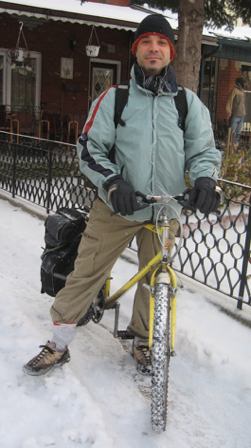 Several of us bike all winter in Toronto which isn’t usually that hard, but this year has gotten off to a very snowy start. Winter cycling can be a bit of an adventure at times. It helps to know a few techniques to deal with the cold, snow and ice. But keep in mind that you can always take a break from riding for a day or two if the weather is too extreme.
Several of us bike all winter in Toronto which isn’t usually that hard, but this year has gotten off to a very snowy start. Winter cycling can be a bit of an adventure at times. It helps to know a few techniques to deal with the cold, snow and ice. But keep in mind that you can always take a break from riding for a day or two if the weather is too extreme.
Image: house member, Joe, who is an avid cyclist.
Why ride in the winter?
Those who have not tried winter riding may be wondering why someone would do something that seems so risky and difficult. Here are some advantages:
- Saves time. Cycling in the city is much faster than transit and most car trips. I have zipped past many a car stuck in traffic congestion, and because my tires cut through snow I can pass cars spinning their wheels on hilly streets.
- Convenience. When you ride most of year, you get used to the convenience of not having to rely on public transit, or finding a parking spot for your car. I have pannier bike bags for carrying groceries and other heavy stuff. If I were to walk instead, I would have to lug that load around.
- Riding is much better for the environment if your alternative is driving. And no need to worry about clearing snow and ice off your car, buying gas, finding parking, etc.
- If your alternative is public transit, then the biggest advantage is not having to wait for a bus while standing in the cold. And no need to worry about picking up germs in crowded buses or trains.
- Great form of outdoor exercise in the fresh air.
- Many winter days are sunny, dry and beautiful – making for very pleasant riding conditions as long as you dress warmly.
- And then, or course, there is the thrill of a challenge.
Riding tips for snowy, wet, wintery days
- Watch out for black ice. If you hit some, ride straight over it without peddling, turning or braking.
- On compacted snow or white ice I can get decent traction, but I will ride standing up if the conditions feel slippery. This way I can quickly put one foot down on the road should the bike slip.
- Test how slippery the road is. Quickly accelerate your back wheel to see if it grips or slips. While going slowly, try applying your back brake fully. This way you will get a feel for how much traction there is.
- If possible stick to side streets as they are usually more pleasant and safe.
- After a snow fall, main streets may have less room for bikes due to the space taken up by snow banks. If the cars are moving slowly consider taking up a whole lane, or let the faster cars pass, then take the whole lane. Avoid busy streets if possible, especially if they have streetcar tracks.
- Brake carefully, and plan for it to take longer to stop. I am always prepared to put my foot down on the pavement if necessary to help stop. In snowy and wet conditions, pump the brakes frequently to keep rims clear.
- Take corners slower and don’t lean as much as on dry days.
- Avoid bad sections or obstructions in the road. I will sometimes ride on an empty sidewalk for a stretch to get around a particularly icy or slushy section. And it is always an option to get off your bike and walk it.
- Streetcar tracks can be more slippery and icy in the winter (especially after a snow fall). Walk your bike over them, or cycle across at a right angle while keeping your pedals horizontal, standing up and flexing your arms and legs to absorb any shock.
- It is best not to use an iPod while winter riding, or at least keep the volume low. I had an accident last year while listening to an iPod that resulted in a sprained thumb. Because my hearing was distracted, I turned too quickly and slipped when I suddenly noticed a car in my way.
